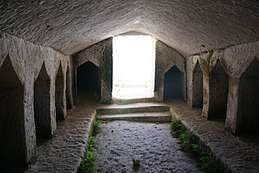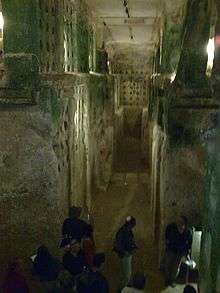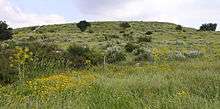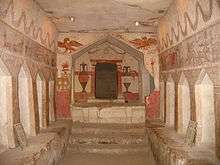Maresha
Tel Maresha (Hebrew: תל מראשה) is the tell (archaeological mound) of the biblical Iron Age city of Maresha, and of the subsequent, post-586 BCE Idumean city known by its Hellenised name Marisa,[1] Arabised as Marissa (ماريسا).[2] The tell is situated in Israel's Shephelah region, i.e. in the foothills of the Judaean Mountains. It was first excavated in 1898-1900 by the British archaeologists Bliss and Macalister on behalf of the Palestine Exploration Fund and again after 1989 by Israeli archaeologist Amos Kloner on behalf of the Israel Antiquities Authority.[1] The majority of the artifacts of the British excavation are to be found today in the Istanbul Archaeology Museums.
| UNESCO World Heritage Site | |
|---|---|
 Maresha: Northern Cemetery | |
| Location | Shfela, Israel, |
| Part of | Caves of Maresha and Bet-Guvrin in the Judean Lowlands as a Microcosm of the Land of the Caves |
| Criteria | Cultural: (v) |
| Reference | 1370 |
| Inscription | 2014 (38th session) |
| Coordinates | 31°35′35″N 34°53′54″E |
 Location of Maresha in Israel | |
This site is now protected as part of Bet Guvrin-Maresha National Park and recognized by UNESCO as a World Heritage Site.[3]
History
Iron Age to Hellenistic Period
Maresha was one of the cities of Judah during the time of the First Temple and is mentioned as part of the inheritance of the biblical tribe of Judah in the Book of Joshua (Joshua 15:44).
Later, in the second Book of Chronicles, it is named as one of King Rehoboam's fifteen fortified cities (2 Chronicles 9:8). In 2 Chronicles 14:9-12 it is the site of a battle against an invading Ethiopian army.
According to the Madaba Map, Maresha was the place "whence came Micah the Prophet".[4] In the 6th century BCE, as result of Zedekiah's rebellion against the Babylonian kingdom and its king Nebuchadnezzar II, the latter occupied the Judean kingdom and sent many of its inhabitants into exile. This marked the end of Maresha as a Judahite city.

Following these events, Edomites who had lived east and south of the Dead Sea migrated to the area. Hence, from the Persian rule and throughout the Hellenistic kingdoms' rule in the region (6th – 1st century BCE), Maresha was part of the area known as Idumea, a Hellenised form of Edom.
Maresha emerged as a major Idumean city and with the conquest of the region by Alexander the Great the city was settled by retired Greek soldiers as was then custom. Thus Maresha developed as a Hellenistic city encompassing a multitude of Greek and oriental cultures including Sidonians and Nabataeans. With the advent of Hellenisation, the settlement pattern changed, as most everywhere in the region, and the city expanded far beyond the constraints of the fortified, raised tell or mound of Iron Age Maresha.
Decline and fall

The city began its decline during the Maccabean Revolt against the Seleucid Empire (2nd century BCE) when the city was used as base to combat the rebels.[5]
Following the rebellion and its success, it is believed that John Hyrcanus conquered the city in 112 BCE, forcibly converting its inhabitants.[6]
In 63 BCE, as part of the arrangements made by Pompey in the region, Maresha, along with all of Edom, was separated from the Jewish kingdom and returned to Idumea. In 47 BCE Julius Caesar then annexed the city to Judea.[7]
Maresha was finally destroyed in 40 BCE by the Parthians as part of the power struggle between Antigonus of the Hasmoneans who had sought their aid and Herod, who was a son of the converted Antipater the Idumaean and was being supported by the Romans.
After Maresha: Beth Gabra/Eleutheropolis
After the demise of Maresha, the neighbouring Idumean/Jewish town of Beth Gabra or Beit Guvrin succeeded it as the main settlement in the area. Shaken by two successive and disastrous Jewish revolts against Roman rule in the 1st and 2nd centuries, the town recovered its importance only at the beginning of the 3rd century when it was re-established as a Roman city under the new name of Eleutheropolis. By the time of Eusebius of Caesarea (d. 340 CE), Maresha itself was already a deserted place: he mentions the city in his Onomasticon, saying that it was at a distance of "two milestones from Eleutheropolis".
Modern era
The Palestinian Arab village Bayt Jibrin, standing on the site of ancient Eleutheropolis, was depopulated during the 1948 Arab-Israeli war. In 1949 Kibbutz Beit Guvrin was established on part of Bayt Jibrin's lands. Most of the archaeologically important areas of ancient Maresha and Beit Guvrin/Eleutheropolis are now part of the Beit Guvrin-Maresha National Park.
Archaeology

Archaeological excavations have been conducted at the site since 2002, continuing as late as 2010, and 2013–2014, by Alpert Berni and Stern Ian on behalf of the Israel Antiquities Authority (IAA).[8] Less than 10 percent of the caves on Tel Maresha have been excavated. Located some 1,300 feet above sea level, the ground is chalky and soft, lending itself to the digging of caves which were used as quarries, burial grounds, animal shelters, workshops and spaces for raising doves and pigeons. Many of the caves are linked by an underground maze of passageways.[9]
Tel Maresha and national park
Today Maresha is part of the Israeli national park of Beit Guvrin. Many of the ancient city's olive presses, columbaria and water cisterns can still be seen. Furthermore, the Archaeological Seminars Institute, under the license of the Israel Antiquities Authority, conducts excavations of Maresha's many quarried systems, and invites visitors to participate.
See also
- Ancient synagogues in the Palestine region
- Archaeological Seminars Institute
- Archaeology of Israel
- Bayt Jibrin for most elaborate presentation (history, archaeology etc.)
- Beit Guvrin-Maresha National Park
- Eleutheropolis
- Kibbutz Beit Guvrin
- LMLK seal - seal impressions on jars from the time of King Hezekiah (ruled c. 715-686 BCE)
- Tourism in Israel
References
- Avraham Negev and Shimon Gibson (2001). "Mreshah (Tell); Marissa; Sandahannah (Tell)". Archaeological Encyclopedia of the Holy Land. New York and London: Continuum. p. 315. ISBN 0-8264-1316-1.
- The Interpreter's Bible,1956, Abingdon Press, Volume VI, page 897
- "Caves of Maresha and Bet-Guvrin in the Judean Lowlands as a Microcosm of the Land of the Caves".
- "Archived copy". Archived from the original on 2016-09-19. Retrieved 2014-03-24.CS1 maint: archived copy as title (link)
- Mysterious Caves of Maresha by Ian Stern at academia.edu. Three fragments of a Greek inscription, believed to be part of the Heliodoros stele were recently found at an Israel Antiquities Authority excavation at the National Park of Beit Guvrin.
- Josephus, Antiquities Book xxii chapter 9 paragraph 1
- David Noel Freedman, Allen C. Myers, Astrid B. Beck (2000) Eerdmans Dictionary of the Bible ISBN 0-8028-2400-5 p 856
- Israel Antiquities Authority, Excavators and Excavations Permit for Year 2010, Survey Permit # A-5808; Excavators and Excavations Permit for Year 2013, Survey Permit # A-6701; Excavators and Excavations Permit for Year 2014, Survey Permit # A-7015
- Amateur Archaeologists Get the Dirt on the Past, New York Times
Bibliography
- Kloner, Amos, Maresha Excavations Final Report I: Subterranean Complexes 21, 44, 70 (Jerusalem, Israel Antiquities Authority, 2003).
- Jacobson, D. M., The Hellenistic Paintings of Marisa (London, Palestine Exploration Fund, 2005).
External links
| Wikimedia Commons has media related to Maresha. |
- Bet Guvrin-Maresha National Park – official site
- Pictures of Maresha